Violin
With A Horn
by Gerhard
Kress
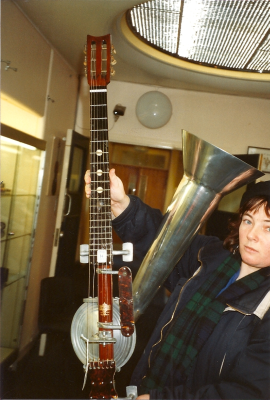 WHAT
IT LOOKS LIKE: Picture a violin, and now take off the bit of
wood that makes up the body. That leaves you essentially with the
neck, the fingerboard, the pegbox and the strings. And you still
need a bridge and some sort of shoulder rest.
WHAT
IT LOOKS LIKE: Picture a violin, and now take off the bit of
wood that makes up the body. That leaves you essentially with the
neck, the fingerboard, the pegbox and the strings. And you still
need a bridge and some sort of shoulder rest.
Where the body was there is now a long, fat and round
piece of wood. Attached to it is the bridge which is connected to a
round and hollow aluminium disc which houses a diaphragm. When the
strings are touched with a bow, the movement causes the bridge to
vibrate. This is transmitted via a thin stem to the diaphragm. At
the end of this is a large, conical aluminium horn. This is where
the sound comes out. The player also gets a much smaller horn
directed towards her ear.
WHAT IT SOUNDS LIKE: Bloody awful.
Contemporary adverts were wilfully misleading by describing the
sound as the equal to a traditional violin. But the sound quality
was not the issue. The fact that the sound could be directed by
pointing the horn made it relevant to the recording industry. It’s
also quite loud, with a sound more akin to playing an empty tin of
beans.
ABOUT THE INVENTOR: Augustus Stroh was born in
Frankfurt-am-Main in Germany. He excelled as an apprentice
watchmaker. He visited the Great London Exhibition in the 19th
Century and was said to have appreciated the relative freedom of the
sciences. He stayed, build up a business, which he eventually sold,
retired and carried on working in his workshop. He became an equal
associate of Sir Charles Wheatstone, who, contrary to the myth, did
not invent the Wheatstone Bridge but merely presented it to the
Royal Society. They had joint patents in addition to Stroh’s own
patents.
At one point Stroh followed instructions send by
cable from Edison to recreate his phonograph, a recording device.
Stroh presented and demonstrated this to the Royal Society. And he
was said to have improved upon it. In 1899 and in 1901 Stroh took
out patents that described the Strohviolin. A systematic production
of Strohviolins followed.
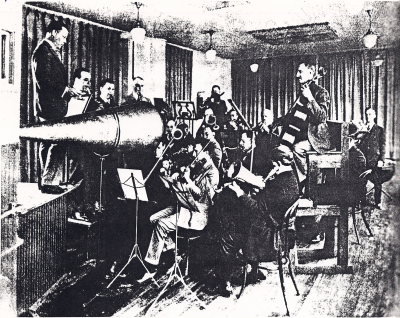 RECORDING
TECHNIQUE: The earliest recordings of sound were enabled by the
phonograph, invented
RECORDING
TECHNIQUE: The earliest recordings of sound were enabled by the
phonograph, invented
by Edison. Voice and music and even whole music
ensembles could be recorded. Some instruments were easier to record
than others. Wind instruments could be pointed where the sound
needed to be, but violins were difficult because the sound travels
away from the instrument in all directions. They could not easily
compete with other instruments. The Strohviol made directional sound
possible.
Setting up a recording session would require two
rooms: one for the orchestra and next door for the phonograph. A
round hole in the partition would allow for a very large horn to be
positioned. The small end of the horn lead to the phonograph, where
sound would enable a needle to make sound-equivalent indentations in
a wax cylinder. The horn travelled through the hole in the wall. Its
other end had a large aperture. The orchestra would be positioned
around the horn as near as possible. The musicians had to put up
with awkward working conditions. It was possible to indent more than
one wax cylinder at the same time. The invention of microphones and
the use of electricity made wax and the Stroh redundant.
TODAY’S USE OF THE STROHVIOL: The Strohviol is
said to have been used in the Music Hall. There certainly is
photographic evidence of the one-stringed Strohviol being used on
stage. It is sometimes known by the name of Phonofiddle or Howson,
after the music retailer who had commissioned the making of those
instruments. I have evidence of a role being played in Jazz. Not
long after the invention of the Strohviol, the principle was adapted
for the use of guitars by Dobro and National. These guitars are
still popular today.
In Morris Dancing I have used the Strohviol when I
play for RAG Morris in Bristol. It has also been used by other teams
as well as folk bands. The Furey brothers had a record sleeve that
prominently displayed a Stroh instrument, a guitar.
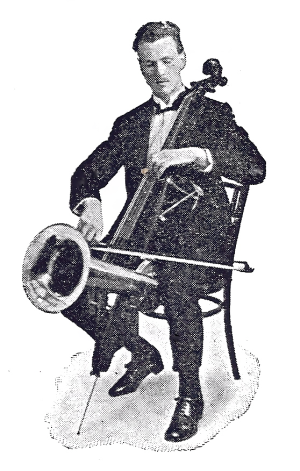 STROH-BASED
INSTRUMENTS: Apart from the aforementioned Dobro and National
wood or metal-based guitars, there have been many other makers using
the Stroh system. But the actual Strohviols came in several
different permutations. There was the single-string Strohviol, held
between the knees like a cello with just one string and a sliding
hand seeking different positions to make a melody. These came in a
simple version with a straight fingerboard and a concert version
with a curved fingerboard. And then there was the Stroh cello, much
larger and with four proper strings and a bigger horn. The double
bass is huge and looks impressive. There were Stroh guitars,
mandolins and ukuleles.
STROH-BASED
INSTRUMENTS: Apart from the aforementioned Dobro and National
wood or metal-based guitars, there have been many other makers using
the Stroh system. But the actual Strohviols came in several
different permutations. There was the single-string Strohviol, held
between the knees like a cello with just one string and a sliding
hand seeking different positions to make a melody. These came in a
simple version with a straight fingerboard and a concert version
with a curved fingerboard. And then there was the Stroh cello, much
larger and with four proper strings and a bigger horn. The double
bass is huge and looks impressive. There were Stroh guitars,
mandolins and ukuleles.
MY INTEREST IN STROH: After qualifying in my
profession I became a full-time busker on the streets of British
cities. I played the violin, but remembered that I had seen my first
Strohviol in a little music shop in Crawley in 1977 (the early
Hobgoblin.) It was £100 and far out of my reach. I reasoned that a
Stroh would give me better earning potential. I also liked the fact
that like me, Augustus Stroh was an immigrant in this country,
coming from the city where I was born.
I travelled a long way when I eventually bought my
first Stroh. I later bought up the collection of a man in the north
of England who had specialised in Wheatstone and other concertinas
and had some of the earliest artefacts, which he largely sold to the
Horniman Museum.
I also started to research the subject of the
Strohviol and its inventor. I was helped in this by becoming a
member of the Galpin Society, which specialises in historic research
of musical instruments. An article by Pilling set me on course to
look for more articles and old photographs of recording sessions as
well as many types of instruments using the Stroh principle. I now
have a large archive of information and photos, some of which have
not yet been published - and all this well before the internet has
made information much easier to come by, while also being guilty of
perpetuating myths. I have come across interesting artefacts in
various museums and collections, including a whole quartet of
Stroh’s at a museum in Copenhagen, which have been used for making
period recordings.
Back to Top
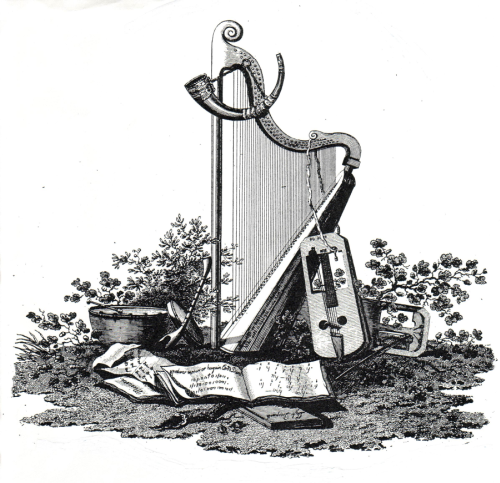

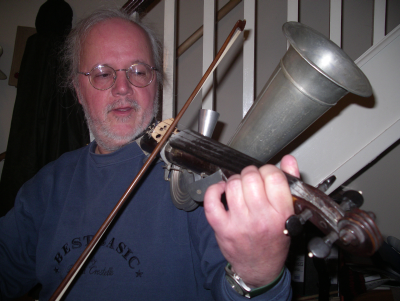
 WHAT
IT LOOKS LIKE: Picture a violin, and now take off the bit of
wood that makes up the body. That leaves you essentially with the
neck, the fingerboard, the pegbox and the strings. And you still
need a bridge and some sort of shoulder rest.
WHAT
IT LOOKS LIKE: Picture a violin, and now take off the bit of
wood that makes up the body. That leaves you essentially with the
neck, the fingerboard, the pegbox and the strings. And you still
need a bridge and some sort of shoulder rest.  RECORDING
TECHNIQUE: The earliest recordings of sound were enabled by the
phonograph, invented
RECORDING
TECHNIQUE: The earliest recordings of sound were enabled by the
phonograph, invented STROH-BASED
INSTRUMENTS: Apart from the aforementioned Dobro and National
wood or metal-based guitars, there have been many other makers using
the Stroh system. But the actual Strohviols came in several
different permutations. There was the single-string Strohviol, held
between the knees like a cello with just one string and a sliding
hand seeking different positions to make a melody. These came in a
simple version with a straight fingerboard and a concert version
with a curved fingerboard. And then there was the Stroh cello, much
larger and with four proper strings and a bigger horn. The double
bass is huge and looks impressive. There were Stroh guitars,
mandolins and ukuleles.
STROH-BASED
INSTRUMENTS: Apart from the aforementioned Dobro and National
wood or metal-based guitars, there have been many other makers using
the Stroh system. But the actual Strohviols came in several
different permutations. There was the single-string Strohviol, held
between the knees like a cello with just one string and a sliding
hand seeking different positions to make a melody. These came in a
simple version with a straight fingerboard and a concert version
with a curved fingerboard. And then there was the Stroh cello, much
larger and with four proper strings and a bigger horn. The double
bass is huge and looks impressive. There were Stroh guitars,
mandolins and ukuleles.